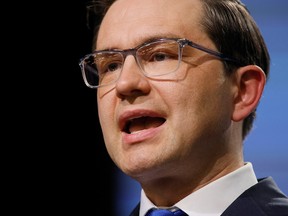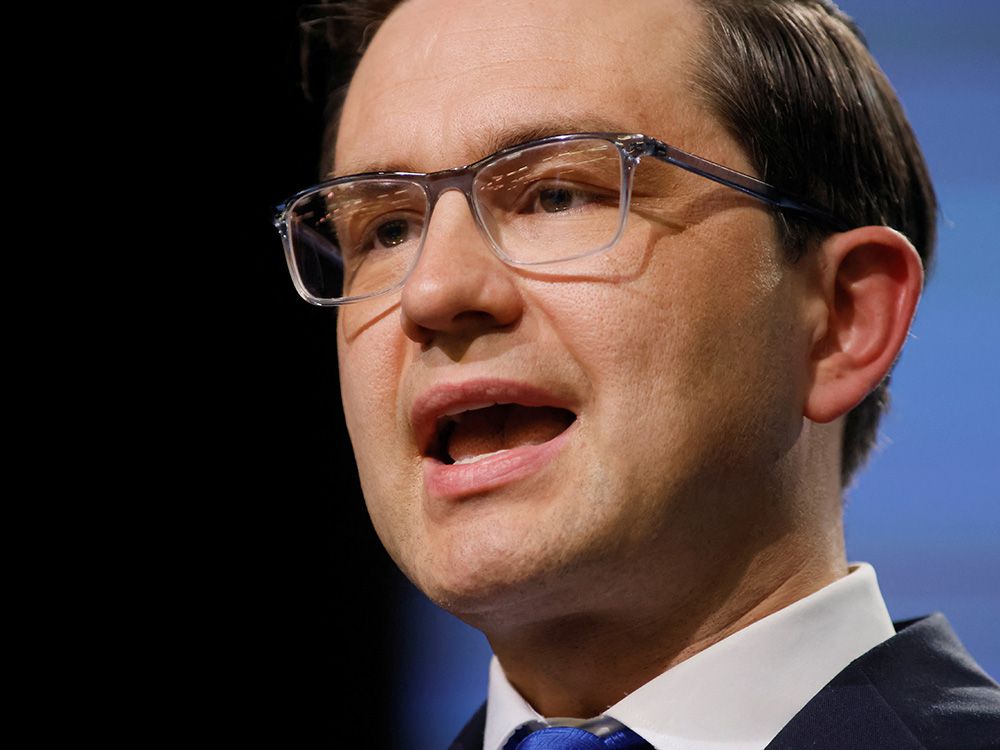The Tory frontrunner is going after the head of the Bank of Canada. Kevin Carmichael offers some history and perspective

Article content
Pierre Poilievre, the perceived frontrunner in the race to lead the Conservatives and become head of the Opposition, stepped up his criticism of the Bank of Canada, saying he would fire governor Tiff Macklem if he becomes prime minister. Here’s what you need to know.
Advertisement 2
Article content
Why the fuss?
Here’s what Poilievre, member of Parliament for Carleton, a riding on the outskirts of Ottawa, said he’d do with Macklem during a debate with the other leadership candidates in Edmonton on May 11: “I would replace him with a new governor who would reinstate our low-inflation mandate, protect the purchasing power of our dollar, and honour the working people who earned those dollars.”
Later in the debate, the 42-year-old career politician used the F word: “I will fire the governor of the central bank to get inflation under control.”
That’s unusual, since there’s a code in Ottawa that arm’s-length Crown corporations, especially the central bank, should be spared that level of political attack as it undermines confidence that technocrats will be left alone to do their work without interference from elected officials.
Advertisement 3
Article content
Does it matter?
In some ways, it doesn’t. To make good on his threat, Poilievre will first have to win the leadership vote on Sept. 10. He would then have to win the next federal election, which probably won’t happen until the autumn of 2025 if the minority Liberal government and the New Democratic Party stay true to their power-sharing agreement. By then, it could be time to start looking for a new governor, no matter who is running the Prime Minister’s Office. Macklem’s seven-year term ends in June 2027.
However, Poilievre’s threat comes at a delicate time for the Bank of Canada. Macklem last month conceded that he and his deputies had misjudged the strength of inflation, implying they probably left interest rates too low for too long. The consumer price index surged 6.7 per cent in March from a year earlier, one of the fastest rates of growth since the early 1980s. The Bank of Canada’s primary mission is to keep the consumer price index advancing at a year-over-year pace of about two per cent.
Advertisement 4
Article content
Central banks almost everywhere are in a similar predicament, but that excuse probably only goes so far with a public that has made its dislike of inflation very clear to pollsters. The Bank of Canada has a credibility issue that probably won’t be resolved until it deflates the cost of living, which Macklem has pledged to do. He raised the benchmark interest rate a quarter-point on March 2, a half-point on April 13, and has all but said there will be another half-point increase on June 1. That would put the policy rate at 1.5 per cent ahead of the summer. He has also said he’s prepared to push the rate above three per cent if that is what is needed to take the heat out of prices.
That brings us back to Poilievre, who is backed by 53 members of the Conservative caucus, compared with Jean Charest’s 13 endorsements.
Advertisement 5
Article content
To some extent, controlling inflation is about psychology: if we have faith in the Bank of Canada to get inflation back to two per cent, we probably won’t insist on cost-of-living adjustments of seven or eight per cent. Poilievre is actively undermining confidence in the central bank’s ability to execute its mission. He has a unique ability to sow doubt because he has captured the imagination of the mainstream press the same way Donald Trump did on his way to the White House. That means his words are amplified on a regular basis. At the same time, Poilievre is more than capable of getting his message out on his own: he has nearly 371,000 Twitter followers and tens of thousands of people watch his YouTube videos.
Is this new?
Advertisement 6
Article content
The Bank of Canada has been here before. James Coyne, who served as governor from 1955 to 1961, resigned amid a political and personality clash with former prime minister John Diefenbaker. That episode led to the rewriting of the Bank of Canada Act, as Coyne’s successor, Louis Rasminsky, insisted on clear guidelines that would leave the central bank alone to manage monetary policy on a day-to-day basis. Diefenbaker rewrote the law to state that if the government disagreed with monetary policy, it would issue a formal directive on what it wanted the central bank to do. If the governor ever disagrees, it’s understood that he or she will resign.
More recently, another career politician, Jean Chrétien, was highly critical of Bank of Canada governor John Crow on his way to winning the 1993 election for the Liberals. Crow favoured zero inflation and the high interest rates required for that approach to monetary policy were choking economic growth. However, Chrétien never intended to fire Crow, at least according to Paul Martin. “John Crow symbolized monetary probity to the markets, so I wanted him to stay,” Martin, who was Chrétien’s first finance minister, wrote in his political memoir. “Jean Chrétien wanted him to stay for the same reason, despite having been very critical of him when we were in Opposition. If we let him go, we thought, it was going to be a major blot on our economic copybook before we even got started.”
Advertisement 7
Article content
Crow’s term was up for renewal a couple of months after the Liberals were elected in November. Martin wrote that he wanted an inflation target of around two per cent, while Crow insisted the target should be closer to zero. Martin appointed Gordon Thiessen, Crow’s deputy, instead.
What’s Poilievre’s problem?
Poilievre, a longtime member of the House finance committee, tends to take an orthodox approach to economics. He dislikes quantitative easing (QE), an aggressive approach to monetary policy whereby central banks create money to purchase financial assets, usually government bonds, because they tend to serve as a benchmark for other assets. The Bank of Canada, along with many other central banks, deployed QE during the COVID-19 recession after it dropped its policy rate to nearly zero. Poilievre accused the Bank of Canada of being the federal government’s “ATM.”
Advertisement 8
Article content
Poilievre’s critique of QE is based on the tenet that more money chasing fewer goods is necessarily inflationary. However, QE didn’t cause runaway inflation a decade ago when central banks in the United States and Europe aggressively used it to reverse the Great Recession. Central bankers mostly stopped worrying about the money supply decades ago, and some economists, including former Bank of Canada governor Stephen Poloz, are skeptical that QE does much more than signal to bond traders where interest rates are headed.
-

‘We’re not getting it perfect’: Carolyn Rogers says the Bank of Canada is learning from its mistakes
-

‘That’s bull****’: David Dodge fires back at Poilievre’s criticism of the Bank of Canada
-

Bank of Canada’s Carolyn Rogers seeks to shore up central bank’s credibility amid political attacks
Advertisement 9
Article content
The current burst of inflation could spark a rethink of the role money creation plays in the economy, but any critique that puts the blame for inflation on central banks overstates their role, because most of the price pressure is the result of supply constraints related to the pandemic and the surge in commodity prices related to Russia’s invasion of Ukraine.
“It has to be said and repeated: This current round of inflation, this latest leg up, has nothing to do with what the BoC was implementing two years ago,” said Bay Street economist David Rosenberg, founder of Toronto-based Rosenberg Research. “It’s totally ridiculous.”
Here’s what the Bank of Canada has to say: “It’s not the bank’s role to comment on political debates,” said Paul Badertscher, director of media relations at the Bank of Canada. “Governor Macklem was appointed by the Bank of Canada’s board of directors with the approval of the Governor in Council for a seven-year period, and his term runs until June 2027.”
Advertisement 10
Article content
What now?
We wait. The Bank of Canada’s latest forecast predicts inflation will be back to 2.4 per cent by the end of 2024, suggesting that if Poilievre cares about getting the cost of living under control, then he may get his wish years before he would have a chance to fire Macklem.
Poilievre also needs to win the leadership race. Things look good for him, based on the number of elected Conservatives he’s recruited to his side, the relatively large crowds that consistently show up at his events, and the buzz his candidacy is creating. However, his lead is narrower by another important metric: money. Poilievre has raised about $545,000, compared with Charest’s $490,000. The race isn’t over yet.
• Email: kcarmichael@postmedia.com | Twitter: carmichaelkevin


